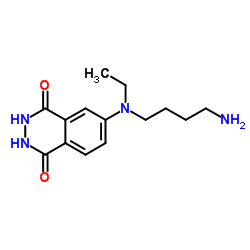N-(4-氨基丁基)-N-乙基异鲁米诺

N-(4-氨基丁基)-N-乙基异鲁米诺结构式

|
常用名 | N-(4-氨基丁基)-N-乙基异鲁米诺 | 英文名 | ABEI |
|---|---|---|---|---|
| CAS号 | 66612-29-1 | 分子量 | 276.334 | |
| 密度 | 1.2±0.1 g/cm3 | 沸点 | N/A | |
| 分子式 | C14H20N4O2 | 熔点 | 259-260 °C(lit.) | |
| MSDS | 中文版 美版 | 闪点 | N/A |
|
A label-free multi-functionalized graphene oxide based electrochemiluminscence immunosensor for ultrasensitive and rapid detection of Vibrio parahaemolyticus in seawater and seafood.
Talanta 147 , 220-5, (2015) A label-free electrochemiluminescence (ECL) immunosensor for ultrasensitive and rapid detection of marine pathogenic bacterium Vibrio parahaemolyticus (VP) in seawater and seafood was developed based on multi-functionalized graphene oxide, which was prepared ... |
|
|
Development of a solid-phase chemiluminescence immunoassay for plasma progesterone.
Steroids 38(1) , 73-88, (1981) A solid-phase immunoassay procedure for the determination of progesterone in human plasma is described, which utilizes chemiluminescence as the end-point. A progesterone-isoluminol conjugate serves as the chemiluminescent marker. An IgG fraction of antiserum ... |
|
|
Enzymatic and kinetic properties of blood coagulation factor XIIIa and guinea pig liver transglutaminase utilizing (6-[N-(4-aminobutyl)-N-ethylamino]-2,3-dihydrophthalazine-1,4-dione, as a novel, specific and sensitive chemiluminescent substrate.
J. Biolumin. Chemilumin. 13(1) , 1-11, (1998) A novel and sensitive chemiluminescent assay is described to quantitate the acyl transfer activities of blood coagulation factor XIIIa or liver transglutaminase using aminobutyl-N-ethylisoluminol as acyl acceptor and N,N-dimethylcasein, human plasma fibrinoge... |
|
|
Chemiluminescent labelled streptavidin (STAV) as a universal marker in steroid and peptide immunoassays.
J. Biolumin. Chemilumin. 4(1) , 112-8, (1989) The tetrameric structure of streptavidin and its exceptionally strong affinity to biotin (Ka = 10(15)M 1) can be exploited to achieve an amplification of the signal in immunoassays. In the approach described here streptavidin (STAV) labelled with aminobutylet... |
|
|
Configuration and optimization of a common two-site immunoassay for human prolactin using a chemiluminescent tracer and an enzymatic tracer.
J. Biolumin. Chemilumin. 4(1) , 587-93, (1989) We have developed a two-site immunoassay for human prolactin using two monoclonal antibodies: one of them immobilized on the solid phase and the other labelled with biotin. The serum is incubated simultaneously with the antibody-coated bead, the biotinylated ... |
|
|
Evaluation of band broadening in chemiluminescence detection coupled to pressurized capillary electrochromatography with an off-column coaxial flow interface.
Electrophoresis 29(2) , 401-9, (2008) A system of off-column coaxial flow chemiluminescence (CL) detection coupled to pressurized CEC (pCEC) was described. The interface utilized a reactor that introduced postcolumn CL reagent into the capillary effluents in a sheathing flow profile. To compare a... |
|
|
The detection of leptospires by a chemiluminescent immunoassay.
J. Med. Microbiol. 21(4) , 353-6, (1986) Rabbit serum hyperimmune to Leptospira interrogans var icterohaemorrhagiae serovar icterohaemorrhagiae, reference strain RGA was conjugated to the chemiluminescent label ABEI (6-[N-(4-aminobutyl)-N-ethyl amino]-2,3-dihydrophthalazine-1,4-dione) in the presenc... |
|
|
Selectivity and sensitivity in the measurement of reactive oxygen species (ROS) using chemiluminescent microspheres prepared by the binding of acridinium ester or ABEI to polymer microspheres.
Luminescence 14(6) , 349-54, (1999) Two kinds of chemiluminescent microspheres were prepared as tools for measuring reactive oxygen species (ROS) released into phagosomes in phagocytizing cells, by chemically binding acridinium ester or ABEI (isoluminol derivative) to polymer microspheres, and ... |
|
|
A novel light-generating system: N-chloramine/H2O2/ABEI/p-iodophenol.
Biomed. Chromatogr. 11(2) , 107-8, (1997)
|
|
|
On-capillary chemiluminescence detection for capillary electrophoresis with a single capillary.
Anal. Sci. 23(6) , 743-6, (2007) On-capillary chemiluminescence detection for capillary electrophoresis with a single capillary was reported. A hole (about 30 microm diameter) was made on the capillary wall at about 50.5 cm from the inlet end. Hydrogen peroxide solution could enter the capil... |